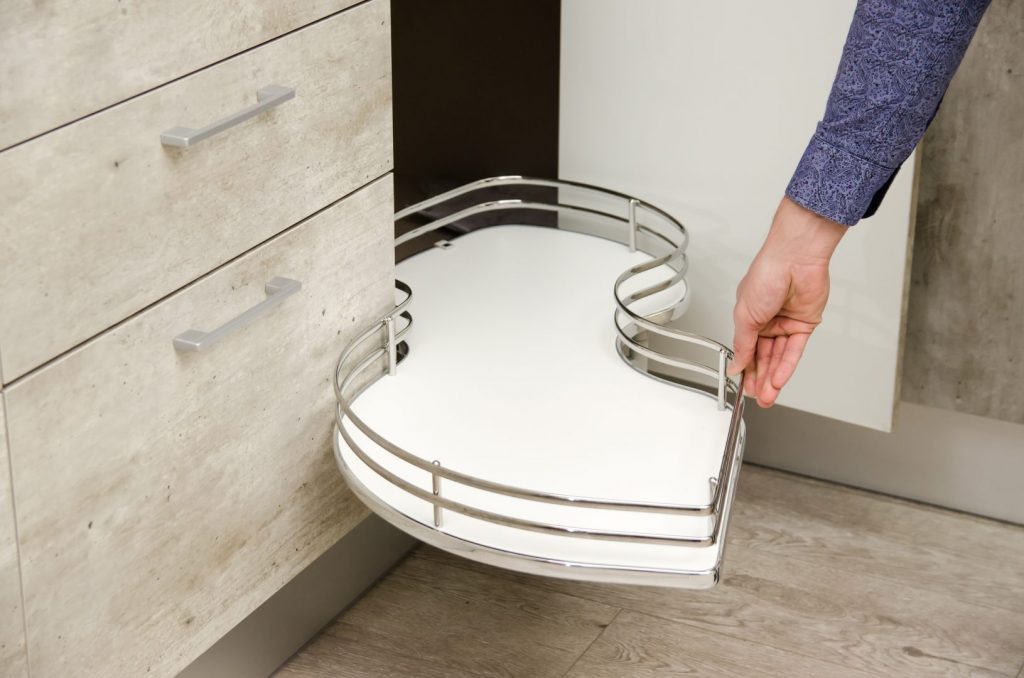
This kitchen swing-out shelf is hidden inside the corner cabinets and pulls out with fingertip ease to reveal everything that is stored on it – and retreats back into the cabinet in the same way .
In 1997, the Center for Universal Design at North Carolina State University created and quantified the seven principles of universal design and gave us these standards to use for anyone desiring to create a universal design solution or treatment in their home or that of a client. These principles are well known and widely accepted.
Anyone familiar with the concept of universal design or wanting to create aging in place solutions that might serve more members of the household than just the specific individual for whom the design was created and implemented, would reference the work of the Center for Universal Design to make sure their solutions were consistent with the design objectives.
With that said, however, there are many products on the market and solutions being created in homes for people who need mobility or safety assistance that are labeled universal design which clearly are not. They may have two or three of the principles embodied in them, or they might even have six of them, but without all seven we really can’t call these products or applications universal design.
True, they might be great products. They might be easy to use. They might make sense for the people using them. They might be better for the client than what they have now. However, none of these “imposters” should be labeled or identified as Universal Design if they do not incorporate these seven guiding principles.
We are seeing products labeled Universal Design in many cases or firms proclaiming that they offer such services almost like a hashtag. It has become a popular marketing term or keyword to include the term Universal Design in one’s brochure, website, or online profile, but it really should deliver what is promised – unless they have a different way of defining Universal Design that has as much market acceptance as that from the Center for Universal Design.
Something might be attractive, fit into the space in which it’s located, be perceptible in what it does and how to use it, and yet require a lot of physical effort to use, operate, or activate it. This is one principle that very often does not measure up in the design and execution of products. It simply is too hard to use and requires too much effort. Opening a window, a door, or a cabinet, or turning on a faucet are examples of what may be just too much effort for someone – depending on how that feature is designed and installed.
Many of these features, while attractive and well done and in some cases fairly expensive, cannot be considered universal because they are too difficult to use. The principle of ease of use or low physical effort simply does not apply, and without this application, we can’t consider the item or the process to be universal. It’s that simple.
Remembering back to our days of high school science or physics, the concept of inertia is where things tend to remain at rest or in motion until acted upon by an outside force. In the case of a closed window or door, it has the physical size, mass, and weight in the particular space where it is where it physically exists. It is remaining in place where it was left and in the same state of being opened or closed as when last used. It obviously is not moving freely and responding to air currents (unless they are quite strong and directional).
Rather, it needs our interaction with it to move it. How much force is required to take an object at rest such as a window that is in the closed or open position, or perhaps a door that is closed, and then to open or close it by moving it from where it is and counteracting gravity and its weight to move it to another position more to our liking? Do we have the strength and range of motion in our arms and shoulders to interrupt its rest and make it respond to our desires? The easier it is to move, the more it complies with the principle of low physical effort. Many people simply do not have the strength, muscle mass, or range of activity to be able to force their windows or doors into compliance.
While other principles of universal design might be missing when we are evaluating a particular feature, the concept of low physical effort is the one that most often is violated or missing. The object can be attractive, compact, easy to understand, and yet without the physical ability to operate it, we cannot call it a great feature or consider it to be what we are striving to achieve for our clients.
Universal design means more than just how something looks. That certainly is a factor – we want universally designed features to fit into the environment where there located and to be attractive. However, we need them to work well for all users. That is an important, sometimes overlooked, concept of creating a universal design application, It must work equally well for anybody who wants to use it – child, adult, small, tall, limited mobility, impaired vision, or any other variety of factors that might need to be considered or overcome to provide equitable usage.
Labeling something as universal design is easy, even if it is not correctly applied. It is important that our clients trust what we are describing as Universal Design and know that it includes all seven of the guiding principles – and possibly even more.
